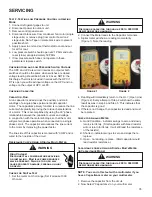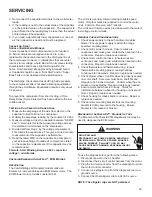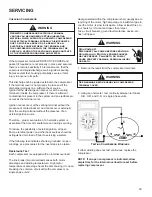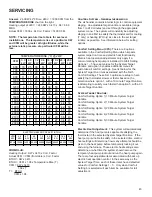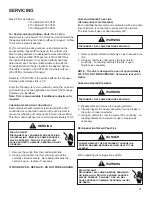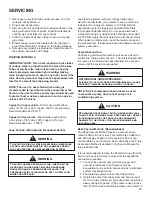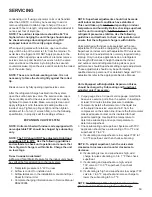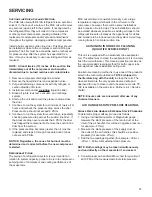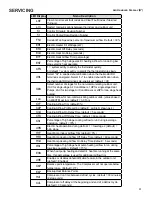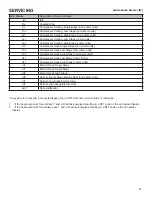
SERVICING
49
considered leak-free; proceed to system charging and
startup.
4. If pressure rises above 1000 microns but holds steady
below 2000 microns, non-condensable air or moisture
may remain or a small leak is present. Return to step
2: If the same result is achieved check for leaks and
repair. Repeat the evacuation procedure.
5. If pressure rises above 2000 microns, a leak is
present. Check for leaks and repair. Repeat the
evacuation procedure.
5000
4500
4000
3500
3000
2500
2000
1500
1000
500
0 1 2 3 4 5 6 7 8 9 10
LEAK(S)
PRESENT
MINUTES
V
ACU
UM
IN
MI
CR
O
NS
CONDENSIBLES OR SMALL
LEAK PRESENT
NO LEAKS
NO CONDENSIBLES
LOW SIDE
GAUGE
AND VALVE
HIGH SIDE
GAUGE
AND VALVE
TO
UNIT SERVICE
VALVE PORTS
VACUUM PUMP
VACUUM PUMP
ADAPTER
800 PSI
RATED
HOSES
CHARGING
CYLINDER
AND SCALE
Evacuation
Triple Evacuation Method (Alternate)
1. Evacuate the system to 4000 microns and hold for 15
minutes. Break the vacuum with dry nitrogen, bring the
system pressure to 2-3 PSIG, and hold for 20 minutes.
Release the nitrogen,
2. Evacuate to 1500 microns and hold for 20 minutes.
Break the vacuum with dry nitrogen again, bring the
system pressure back to 2-3 PSIG, and hold for 20
minutes.
3. Evacuate the system to 500 microns and hold for 60
minutes.
4. If the pressure rises to 1000 microns or less and
remains steady the system is considered leak free;
proceed to start-up.
Charging
WARNING
REFRIGERANT UNDER PRESSURE!
•
Do not overcharge system with refrigerant.
•
Do not operate unit in a vacuum or at negative
pressure.
Failure to follow proper procedures may cause
property damage, personal injury or death.
CAUTION
Use refrigerant certified to AHRI standards.
Used refrigerant may cause compressor
damage and is not covered under the warranty.
Most portable machines cannot clean used
refrigerant to meet AHRI standards.
CAUTION
Damage to the unit caused by operating the
compressor with the suction valve closed is
not covered under the warranty and may cause
serious compressor damage.
Charge the system with the exact amount of refrigerant.
Refer to the specification section or check the unit
nameplates for the correct refrigerant charge. An
inaccurately charged system will cause future problems.
NOTE: R410A should be drawn out of the storage
container or drum in liquid form due to its fractionation
properties, but should be “Flashed” to its gas state
before entering the system. There is commercially
available restriction devices that fit into the system
charging hose set to accomplish this. DO NOT charge
liquid R410A into the compressor.
NOTE: Power must be supplied to the 18 SEER
outdoor units containing ECM motors before the
power is applied to the indoor unit. Sending a low
voltage signal without high voltage power present at
the outdoor unit can cause malfunction of the control
module on the ECM motor.
Adequate refrigerant charge for the matching evaporator
coil or air handler and 15 feet of line set is supplied with the
Summary of Contents for ASXC16
Page 4: ...PRODUCT IDENTIFICATION 4 ...
Page 5: ...PRODUCT IDENTIFICATION 5 ...

